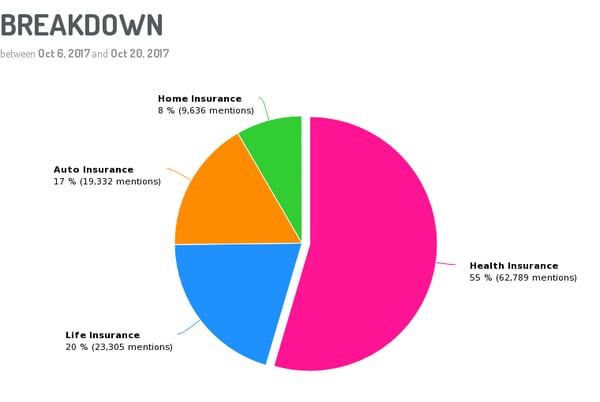How Insurance Brands Develop Social Selling Strategies
A case study on a large insurance company’s use of customer profiling and prospect analysis to generate new business.
Social Selling in the Insurance Industry
As in many industries, a major challenge in the insurance sector is developing new business by creating audience profiles of prospective clients. Successful prospect analysis calls for insurers to recognize the relationship between profitability and brand activity on social media. Policyholders, especially millennials, are increasingly expecting comprehensive and interconnected communication platforms for a consistent customer experience both online and in person.
According to the most recent World Insurance Report from Capgemini, 22% of policyholders cite social media conversations and interactions to have the highest impact on their purchasing processes. This category ranks above the influence of the advice of friends and family, which only 17% of policyholders indicated as most impactful. The following case study will look into a major insurance provider’s success in implementing social intelligence to develop social selling and prospect analysis strategies.
The Challenge
Our client sought to extend the use of their social media strategy beyond the creation of brand awareness and positioning techniques, to using their online presence as a key model in generating new business.
In developing their social media strategy, the following key questions emerged:
- What is the best method for tracking and reaching business prospects?
- How can the insurer take advantage of online conversation spaces in order to deliver well-targeted promotions and messages?
- How can the insurer more heavily involve employees, especially insurance agents, in client prospecting and social selling processes?
 A breakdown of volume of conversation by type of insurance, via Digimind Social.
A breakdown of volume of conversation by type of insurance, via Digimind Social.
The Project
To help answer these questions, our client’s communications and brand management department employed Digimind Social to set up social listening and analysis methods and gather easily understandable data. In effect, their project goal was defined as followed: implement a social selling strategy which will identify and engage prospective clients and accurately track customer conversations on across social media platforms.
The Solution
Five key practices were defined in order to achieve this objective:
- Analyze the common interests and needs of the target audience.
- Isolate meaningful consumer behavior trends across social media channels and conversation spaces and define the most active and credible users that fit the target audience profile.
- Segment the collected data based on conversation trends, volume of mentions, associated sentiment, and by geographic location.
- Share the information in real time with insurance agents via an alert system and with real-time dashboards. Agents can leverage these insights to engage with prospective customers when they are most receptive and cater promotions specifically to their needs.
- Integrate the data with analysis of social media engagement, site traffic patterns, lead generations, and social selling KPIs.
 An analysis of volume of conversation by media channel, via Digimind Social.
An analysis of volume of conversation by media channel, via Digimind Social.
The Results
This social selling project enabled the insurance provider to do the following:
- Optimize the ROI of its online presence
- Improve the efficiency of data analysis and success measurement
- Develop an effective employee advocacy program
- Create new synergy between marketing (prospect mapping) and sales (direct contact)
Key practices observed:
The project’s success revealed four key practices applicable to the insurance sector:
- Listen to Online Customer Conversations
By listening to and analyzing real consumer needs, insurance agents are able to avoid cold calls and uninformed sales pitches. Well-informed agents will also be able to create personalized relationships with their clients by pushing offers tailored to individual client needs.
- Create a Dedicated Customer Service Team
Have customer service employees available to listen to customer issues, complaints, and concerns and give professional advice. Customers will have more confidence in a customer service system where the feel that their interests are put first.
- Look Beyond Proprietary Data
While analysis of proprietary data can offer valuable indicators, such data is often not enough for gaining a fundamental understanding of the target audience. Owned data should be complemented with analysis of consumer conversations occurring across social media platforms.
- Align the Marketing and Sales Teams
Marketing and sales activities are highly dependent on one another. The marketing team must support their salespeople with insights collected from social intelligence and through the development of informed and targeted content in order to help sales cultivate relationships with prospective clients. 
.png?width=100&name=logo%20(1).png)


